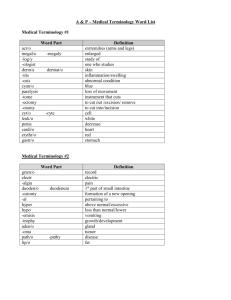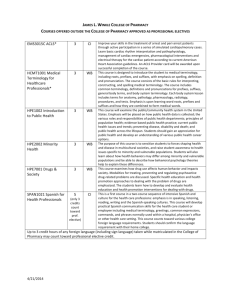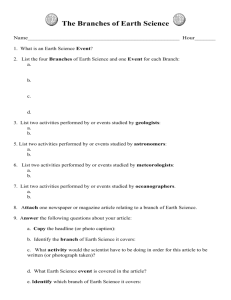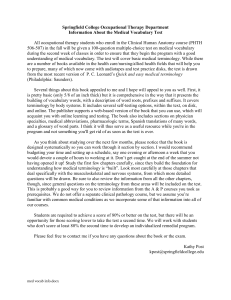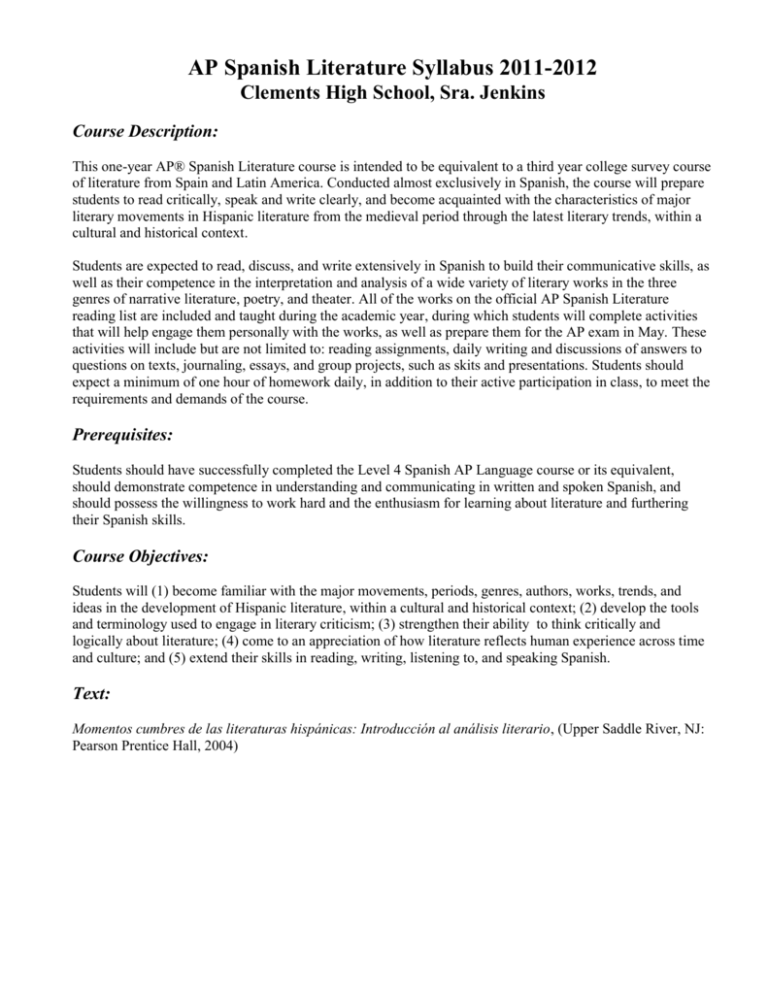
AP Spanish Literature Syllabus 2011-2012
Clements High School, Sra. Jenkins
Course Description:
This one-year AP® Spanish Literature course is intended to be equivalent to a third year college survey course
of literature from Spain and Latin America. Conducted almost exclusively in Spanish, the course will prepare
students to read critically, speak and write clearly, and become acquainted with the characteristics of major
literary movements in Hispanic literature from the medieval period through the latest literary trends, within a
cultural and historical context.
Students are expected to read, discuss, and write extensively in Spanish to build their communicative skills, as
well as their competence in the interpretation and analysis of a wide variety of literary works in the three
genres of narrative literature, poetry, and theater. All of the works on the official AP Spanish Literature
reading list are included and taught during the academic year, during which students will complete activities
that will help engage them personally with the works, as well as prepare them for the AP exam in May. These
activities will include but are not limited to: reading assignments, daily writing and discussions of answers to
questions on texts, journaling, essays, and group projects, such as skits and presentations. Students should
expect a minimum of one hour of homework daily, in addition to their active participation in class, to meet the
requirements and demands of the course.
Prerequisites:
Students should have successfully completed the Level 4 Spanish AP Language course or its equivalent,
should demonstrate competence in understanding and communicating in written and spoken Spanish, and
should possess the willingness to work hard and the enthusiasm for learning about literature and furthering
their Spanish skills.
Course Objectives:
Students will (1) become familiar with the major movements, periods, genres, authors, works, trends, and
ideas in the development of Hispanic literature, within a cultural and historical context; (2) develop the tools
and terminology used to engage in literary criticism; (3) strengthen their ability to think critically and
logically about literature; (4) come to an appreciation of how literature reflects human experience across time
and culture; and (5) extend their skills in reading, writing, listening to, and speaking Spanish.
Text:
Momentos cumbres de las literaturas hispánicas: Introducción al análisis literario, (Upper Saddle River, NJ:
Pearson Prentice Hall, 2004)
Course Materials:
Students will bring to class EVERY DAY:
1. Blue/black pens, other brightly-colored pens, highlighter
2. Covered textbook
3. Binder with at least 2-inch rings (preferably a clear-cover loose-leaf “view” one, where a page can be
inserted in cover), with lined paper, and 14 dividers; follow this format & order:
a. Spanish literature-related Decorated Cover Page (inside plastic front cover or attached/protected):
Your name
Español 5
Período 4
Señora Jenkins
b. Course Syllabus (this one)
c. Divided Sections (Keep all of your notes, answers to questions, handouts, and other materials in
order by date, in the sections corresponding numerically to the unit we study.)
C. Other:
1. Students must also pay $1 to purchase a diario.
2. Please bring the following contribution to a class set: ___________________________.
Course Outline:
Semester 1
Part 1: The Middle Ages through the 18th Century
Unit 1: Narrative of the Medieval Period
Terminology and elements of the narrative genre and strategies for analysis, with focus on didactic narrative
Introduction to the medieval period
Work studied (Chapter 1 & handout)
Juan Manuel, El conde Lucanor, Ejemplo XXXV , “Lo que le sucedió a un mozo que se casó con una
mujer de muy mal carácter”
Unit 2: Narrative of the New World
Terminology and elements of narrative genre and strategies for analysis, with focus on documentary &
testimonial narrative
Introduction to the age of exploration of the New World
Work studied (Chapter 2 & handout):
Álvar Núñez Cabeza de Vaca, fragments of Los naufragios
Unit 3: Poetry of the Medieval Age and Renaissance
Terminology and elements of poetry and strategies for reading and analysis
Introduction to the Renaissance period
Works studied (Chapter 3):
Anonymous, “Romance de la pérdida de Alhama”
Anonymous, “Romance del Conde Arnaldos”
Garcilaso de la Vega: “En tanto que de rosa y azucena,” Soneto XXIII
Unit 4: Prose of the Golden Age
Terminology and elements of the narrative genre and strategies for analysis, with focus on development of
the novel
Introduction to prose of the Golden Age
Works studied (Chapter 4):
Anonymous, Lazarillo de Tormes, Tratados 1, 2, 3, 7
Miguel de Cervantes, Don Quijote de la Mancha Primera parte, Capítulos I, II, III, IV, V y VIII
Unit 5: Theater of the Golden Age
Terminology and elements of theater and strategies for reading and analysis
Introduction to drama of the Golden Age
Work studied (Chapter 5):
Tirso de Molina, El burlador de Sevilla
Unit 6: Baroque Poetry in Spain and the New World
Review of terminology and elements of poetry and strategies for reading and analysis
Introduction to the Baroque period
Works studied (Chapter 6, different order):
Sor Juana Inés de la Cruz
o
“Hombres necios que acusáis” (Redondillas)
o
Sor Juana Inés de la Cruz, “En perseguirme, Mundo, ¿qué interesas?” (Soneto)
Luis de Góngora y Argote, “Mientras por competir con tu cabello,” Soneto CLXVI
Francisco de Quevedo y Villegas, “Miré los muros de la patria mía,” Salmo XVII (Enseña cómo
todas las cosas avisan de la muerte)
Unit 7: Romanticism
Review of terminology and elements of poetry; introduction to the short story; strategies for reading and
analysis
Introduction to Romanticism
Works studied (Chapter 7):
José María Heredia, “En una tempestad” (Silva)
Mariano José de Larra, “Vuelva Ud. mañana” (El pobrecito hablador)
José de Espronceda, “Canción del pirata” (Poesía)
Ricardo Palma, “El alacrán de Fray Gómez” (Tradiciones peruanas)
Gustavo Adolfo Bécquer
o
“No digáis que agotado su tesoro,” Rima IV (Rimas)
o
“Yo soy ardiente, yo soy morena,” Rima XI (Rimas)
o
“Volverán las oscuras golondrinas,” Rima LIII (Rimas)
Semester 2
Part 2: The 19th & 20th Centuries
Unit 8: Realism and Naturalism
Review of terminology and elements of the short story and strategies for reading and analysis
Introduction to Realism & Naturalism
Works studied (Chapter 8):
Emilia Pardo Bazán, “Las medias rojas” (Cuentos de la tierra)
Leopoldo Alas (Clarín), “Adiós, Cordera” (El señor, y lo demás son cuentos)
Horacio Quiroga, “El hijo” (Más allá)
Unit 9: Modernism
Review of terminology and elements of poetry and strategies for reading and analysis
Introduction to Modernism
Works studied (Chapter 9):
José Martí
o
“Yo soy un hombre sincero” (Versos sencillos)
o
“Dos patrias” (Versos libres)
Rubén Darío
o
“Canción de otoño en primavera” (Cantos de vida y esperanza)
o
“Lo fatal” (Prosa profanas)
o
“A Roosevelt” (Prosas profanas)
Alfonsina Storni
o
“Tú me quieres blanca” (El dulce daño)
o
“Peso ancestral” (Irremediablemente)
Julia de Burgos, “A Julia de Burgos” (Canción de la verdad sencilla)
Unit 10: The Generation of ’98 in Spain
Review of terminology and elements of the novel and poetry and strategies for reading and analysis
Introduction to the Generation of ‘98
Works studied (Chapter 10):
Miguel de Unamuno y Jugo, San Manuel Bueno, mártir
Antonio Machado
o “He andado muchos caminos” (Soledades)
o “La primavera besaba” (Soledades)
o “Caminante, son tus huellas,” XXIX (Campos de Castilla, Proverbios y cantares)
Unit 11: Vanguardism
Review of terminology and elements of poetry and theater and strategies for reading and analysis
Introduction to Vanguardism
Works studied (Chapter 11):
Federico García Lorca
o
“Romance de la luna, luna”
o
“Romance sonámbulo”
o
La casa de Bernarda Alba
Nicolás Guillén
o
“Sensemayá”
o
“Balada de los dos abuelos”
Pablo Neruda (Ricardo Neftalí Reyes Basoalto)
o
Poema 15: “Me gustas cuando callas porque estás como ausente” (Veinte poemas de amor y
una canción desesperada)
o
“Walking around”
o
“Oda a la alcachofa”
Sergio Vodanovic, El delantal blanco
Unit 12: Post-Civil War Spain
Review of terminology and elements of the short story and strategies for reading and analysis
Introduction to Post-Civil War Spain
Work studied (Chapter 12):
Carmen Martín Gaite, “Las ataduras”
Unit 13: The Boom in Hispanic American Narrative
Review of terminology and elements of the short story and strategies for reading and analysis
Introduction to Hispanic American Narrative Boom
Work studied (Chapter 13):
Jorge Luis Borges
o
“La muerte y la brújula”
o
“El sur”
Juan Rulfo “No oyes ladrar los perros”
Julio Cortázar
o
“Continuidad de los parques”
o
“La noche boca arriba”
Carlos Fuentes, “Chac Mool”
Gabriel García Márquez, 3-4 of the following stories:
o
“La siesta del martes”
o
“La viuda de Montiel”
o
“Un señor muy viejo con unas alas enormes”
o
“Un día de éstos” (not in book)
o
“El ahogado más hermoso del mundo” (not in book)
o
“La prodigiosa tarde de Baltazar” (not in book)
Unit 14: The Feminine Voice in Contemporary Literature
Review of terminology and elements of the poetry & the short story and strategies for reading and analysis
Introduction to the feminine voice in contemporary literature
Work studied (Chapter 14):
Rosario Castellanos, “Autorretrato”
Isabel Allende, “Dos palabras”
Sabine R Ulibarrí, “Mi caballo mago” (not in book)


